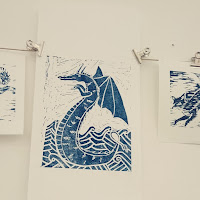For my research methodology project I decided to look at the Pine Marten. Pine Martens are shy, nocturnal animals that have been extinct from England since the 18th century due to hunting and deforestation. They are still found in Scotland and Ireland and in recent years have been reintroduced to Wales. My research started off with looking at the conservation of these animals and the efforts that are being taken into reintroducing them to Wales and possibly England.
During my research I looked at if the Pine Marten had any myths or legends behind it and found very few, but I did find some Native American creation stories that involved the Pine Marten. Pine Martens are seen within Native American beliefs as a brave warrior and protector especially with the Ojibwe/ Ojibway who had a clan named after it, which had their warriors, builders and strategists in.
One of the stories really stood out to me, Pine Marten's quest for Moon's Daughter, in the story different animals are trying to become Moon's daughters suitors, but to do this they have to pass Moon's challenges. Pine Marten is the only one who completes the first challenge and goes on to the others. The part of the story that caught my attention was the ending were Moon is sent into the sky by Pine Marten were he becomes the Moon. As the original story is a direct translation of a spoken tale there are quite a few sentences that don't make sense in English. After having a tutorial with Karen Anne we discussed about transfiguring and rewriting the story to fit Irish animals and making it into a children's story book.
My new version of the story went through lots of changes and versions. I made it so Pine Marten is the protagonist of the story whilst Moon is the antagonist, as in the original both of them seemed to be as bad as each other with no messages of good. I made it so the story showed how much Pine Marten loved moon's daughter (Kyna), and how he would do any number of challenges to be able to marry her. In the end during a challenge pine marten is exhausted and fed up and sends Moon into the sky.


For the double page spreads I made thumbnails of every scene and picked three to illustrate along with a map for the index papers. When designing the characters for the story I got a bit carried away and did roughs of all the characters involved, so I used them and made them into a page introducing the characters to go at the start of the book. I did all of my drawings in black fine liner and scanned them into Photoshop were I then coloured them and added in the text.

During my research I looked at if the Pine Marten had any myths or legends behind it and found very few, but I did find some Native American creation stories that involved the Pine Marten. Pine Martens are seen within Native American beliefs as a brave warrior and protector especially with the Ojibwe/ Ojibway who had a clan named after it, which had their warriors, builders and strategists in.
One of the stories really stood out to me, Pine Marten's quest for Moon's Daughter, in the story different animals are trying to become Moon's daughters suitors, but to do this they have to pass Moon's challenges. Pine Marten is the only one who completes the first challenge and goes on to the others. The part of the story that caught my attention was the ending were Moon is sent into the sky by Pine Marten were he becomes the Moon. As the original story is a direct translation of a spoken tale there are quite a few sentences that don't make sense in English. After having a tutorial with Karen Anne we discussed about transfiguring and rewriting the story to fit Irish animals and making it into a children's story book.
My new version of the story went through lots of changes and versions. I made it so Pine Marten is the protagonist of the story whilst Moon is the antagonist, as in the original both of them seemed to be as bad as each other with no messages of good. I made it so the story showed how much Pine Marten loved moon's daughter (Kyna), and how he would do any number of challenges to be able to marry her. In the end during a challenge pine marten is exhausted and fed up and sends Moon into the sky.


For the double page spreads I made thumbnails of every scene and picked three to illustrate along with a map for the index papers. When designing the characters for the story I got a bit carried away and did roughs of all the characters involved, so I used them and made them into a page introducing the characters to go at the start of the book. I did all of my drawings in black fine liner and scanned them into Photoshop were I then coloured them and added in the text.






































